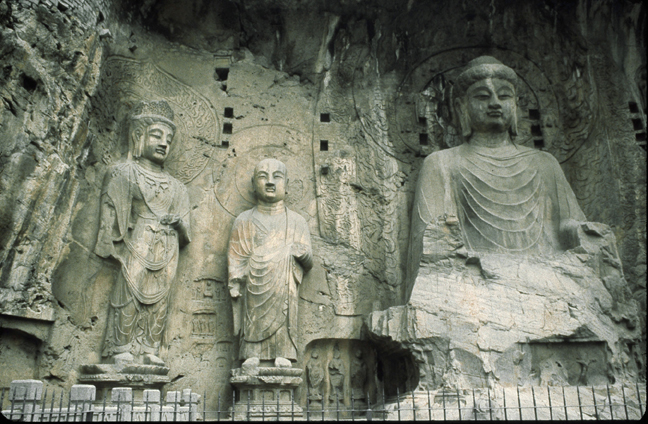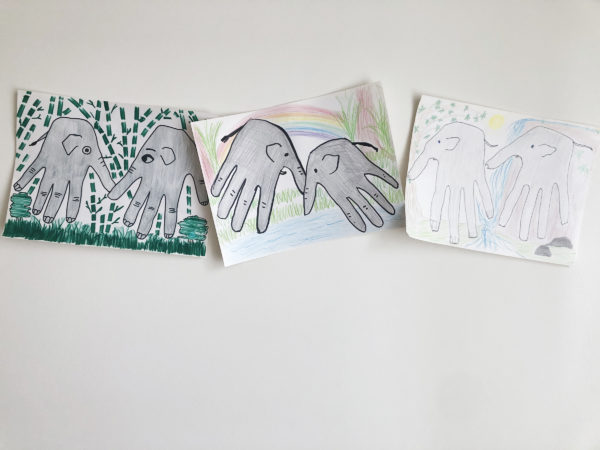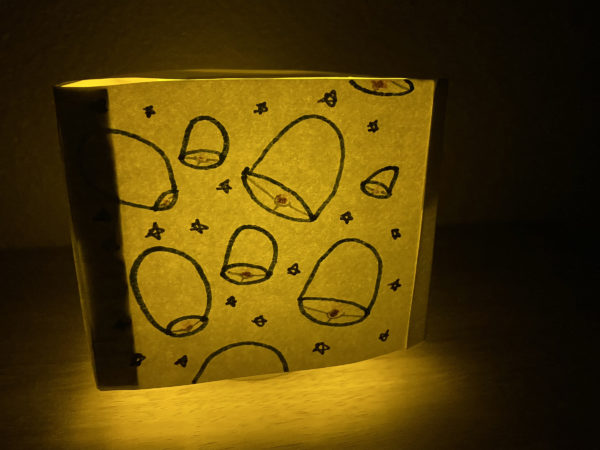Video
Buddhism in the Tang (618–906) and Song (960–1279) Dynasties
Buddhism was founded in northern India in the sixth century BCE. Most historians believe it was introduced to China in approximately the second century by means of monks and traders along the Silk Road.

Buddhist cave shrines at Longmen caves
Buddhism was essentially a foreign religion in a culture with many well-established philosophical and religious traditions, notably Taoism and Confucianism. These three belief systems coexisted to varying degrees during both the Tang and Song dynasties. Confucianism guided the social realm— governance, education, family life, relationships among levels of society. It provided ethical guidelines for maintaining social order. Taoism offered mystical, proto-scientific ideas about one’s health, well-being, procreation, and longevity. In the Chinese context, Buddhism dealt mainly with the afterlife, the effects of good and bad deeds; addressing life’s misfortunes; it also promised release from suffering.
By the Tang dynasty, Buddhist temples and shrines had spread across the country. Buddhism enjoyed a great deal of state support. Then as now, lay people made donations to monks and temples to secure earthly and spiritual rewards. More specifically, they could accrue merit (positive actions resulting in spiritual and practical benefits) through charity, the support of public works (such as refurbishing a local temple), the donation of property, or the commissioning of artworks (a statue, or cave shrine, or production of a set of Buddhist texts). Individuals entering monastic life as monks or nuns still aroused suspicion from some members of society, particularly strict adherents of Confucianism. Sacrificing one’s family name, the possibility of offspring, cutting of one’s hair (a defilement of the body), and embracing poverty ran counter to many time-honored Chinese beliefs.
In a Buddhist context, grand celebrations were often held in honor of rulers, on festival days, in honor of new public works, and to protect the nation from famine or invasion. Some festivals involving the parade of sacred relics were criticized by various members of the court, in particular for arousing hysteria and for lavish expenditures. Buddhism was severely persecuted in 845 and again in the 900s during the Five Dynasties period between the Tang and the Song. Many of the reasons for this suppression were economic. Thousands of temples were destroyed and metal objects melted down for hard currency. Many monks and nuns were forced to return to lay life, where they could contribute to the general tax base.
Despite these persecutions and continuing difficulties accommodating itself on foreign soil, Buddhism for most part thrived among the Chinese population, in particular during the Song when it moved out of the realm of official state sponsorship and into the mainstream of popular religion.
In the artistic realm, Buddhism not only contributed to the development of sculpture during the Tang and Song period, it furthered the development of printed books and religious architecture in China. Scholar John Kieschnick has suggested that the unique combination of Buddhism and Chinese culture also helped further develop the use of the chair, and the popularization of tea in China during this time.
The predominant forms of Buddhism in China were drawn from Mahayana Buddhism, a branch of Buddhism that espoused the possibility of enlightenment for all sentient beings, with the help of bodhisattvas, compassionate, enlightened beings who had postponed their own entry into nirvana in order to help others along the path to enlightenment. These bodhisattvas would become increasingly important figures in Chinese Buddhist arts as time progressed. The main forms of Buddhism present in China during the Tang and Song period (some unique to China) included:
- Tiantai (“heavenly terrace”) Buddhism: A school of Buddhism that aimed to synthesize various existing Buddhist practices; its principle text was the “Sutra of the Lotus of the True Law” (the “Lotus Sutra”—one of the most popular Buddhist texts during the Tang-Song period); it appealed mainly to the literate, ruling classes.
- Avatamsaka (Huayan, “flower garland”) Buddhism: After text of the same name; followed concept of two worlds, li (ultimate principle) and shi (phenomena); this school was supported by Empress Wu of the Tang.
- Pure Land (Jingtu) Buddhism: After text of the same name; described a Western Paradise where believers could be reborn; a very popular school among the mainstream population, a set of beliefs that helped to inspire landscape painting.
- Chan Buddhism: Began in the Tang dynasty but became more popular in Song; founded by legendary Indian monk Bodhidharma in fifth century CE, involved intense physical and mental exercises to gain enlightenment; greatly influenced the arts, including representations of spiritually advanced hermits called arhats (Chinese: luohan).
- Esoteric Buddhism: A more elaborate form of Buddhism involving numerous male and female deities, rituals, incantations, gestures and visualizations; established in the border regions of China in the later Tang; some overlap with practices in Tiantai and Huayan forms of Buddhism.
Buddhist art images of the Tang and Song adorned temples and cave shrines, and were used in private worship and in court-sponsored activities. Many of the objects that have survived consist of stone steles, and freestanding statues of marble, sandstone, and less frequently wood or lacquered wood. Most bronze statues that have survived are generally rather small objects.
Tang religious architecture had a lasting impact on Buddhist architecture throughout East Asia. The wooden structures at Horyuji outside of Nara, Japan have been largely preserved since the 700s. They were modeled after a Tang-dynasty Chinese temple and give us a reasonably good idea of temple layout and construction of that time, since very little survives intact in China. The oldest surviving wooden temple building in China dates from the Tang: Nanchansi at Wutaishan. An image of the exterior of the temple is included in this packet.
Recently, Buddhist reliquary and ritual objects have been found in a secret crypt below a pagoda at Famensi west of Xi’an, and a cache of intentionally broken and buried Buddhist statues (mostly dating from before the Tang) have been uncovered from the remains of temple grounds in Shandong province. These objects give us new insights into particular moments in Chinese Buddhist art and material culture at various times in the past.










